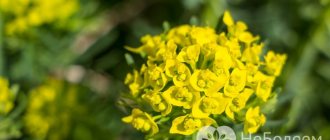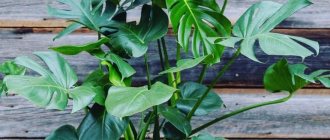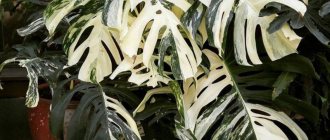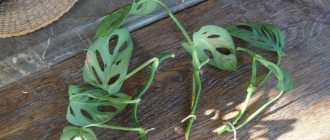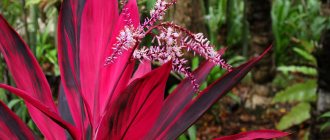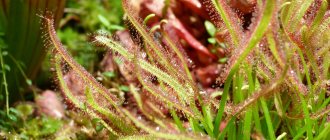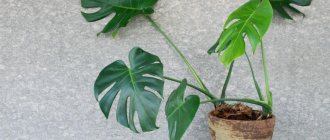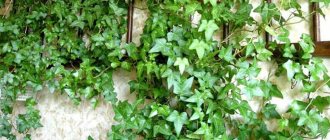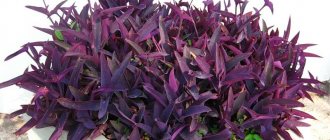Author: Elena N. https://floristics.info/ru/index.php?option=com_contact&view=contact&id=19 Category: Houseplants Published: February 24, 2019Last edits: January 11, 2021
- Growing from seeds
- Monstera turns yellow
- Monstera deliciosa, or attractive (Monstera deliciosa)
Monstera is an old favorite of ours. This luxurious plant can enhance any interior. Even its notoriety does not hinder the growth of its popularity: superstitious people consider the monstera to be an energy vampire that attracts misfortune to the house.
The reason for these speculations is the aerial roots of the plant, which in nature sometimes form entire thickets. And also fruits that leave your mouth feeling like the pricks of many needles. But at home, Monstera does not bloom, so it does not form fruits.
- What conditions does Monstera need for growth and development?
- How to grow monstera at home?
- How to transplant and reproduce it?
You will find answers to these and other questions in our article.
Planting and caring for monstera
- Flowering: the plant is grown as an ornamental foliage plant.
- Lighting: bright diffused light or partial shade.
- Temperature: in summer – normal for residential premises, in winter – 12-14 ˚C.
- Watering: regular and plentiful: the substrate should be slightly moist all the time.
- Humidity: high. It is recommended to regularly spray and wash the leaves with a damp sponge.
- Feeding: from March to August twice a month with complex mineral fertilizer for decorative deciduous plants; during the rest of the year, Monstera does not need fertilizing.
- Rest period: not clearly expressed.
- Transplantation: young plants are replanted annually, four-year-old plants - once every 2-3 years, old ones - once every five years, but the top layer of substrate up to 5 cm thick must be changed in pots of large plants annually.
- Garter: the vine is tied to a support dug into the potting soil - a ladder, a tube filled with moss or an artificial trunk wrapped in copra.
- Reproduction: sometimes by seeds, but more often vegetatively (cuttings and shoots).
- Pests: ivy scale insects, thrips, mealybugs and spider mites.
- Diseases: sooty fungus, stem rot.
Read more about growing monstera below.
plant (lat. Monstera) is a large vine and belongs to the Araceae family. In nature, monstera flowers grow in the tropical forests of the equatorial regions of Central and South America from the Yucatan Peninsula and Mexico in the north to Brazil in the south. At the end of the 18th century, the monstera flower was introduced to Asia, and then spread throughout Europe and Australia. I would like to believe that the name Monstera comes not from the Latin word Monstrum, meaning monster, but from monstrosus, which means “amazing, bizarre,” but the myths that haunt the plant cast doubt on this.
- Cucumbers will be of the highest class - how to sow, pick, plant, shape and harvest cucumbers correctly?
European explorers of the South American tropics were not so much surprised by the tree as they were frightened: the monstera vine is of such impressive size that it looks intimidating. And where fear arises, legends are born, for example, that the monstera is an energy vampire, that the roots of the monstera entangle the victim and strangle him, and all that. Let’s not retell fables, but rather let’s talk about what the monstera indoor flower actually is in modern floriculture.
Interesting facts about Monstera deliciosa
There are many myths about the plant. The most common rumors are that monstera is poisonous, brings trouble to the house and takes away energy from the residents. There is no scientific confirmation of this, so you can safely start a vine in your apartment.
Monstera flower - what the plant and leaf look like
What interesting things are known about Monstera Deliciosa:
- from Latin the name “monstrum” is translated as “monster”. It occurred thanks to creeping stems, the diameter of which reaches 20 cm and has long aerial roots;
- according to another version from Latin, the name is translated as “bizarre”, “amazing”, which fully corresponds to its appearance;
- Princess of Brazil Isabella of Braganza, daughter of Emperor Pedro II, started the tradition of eating monstera fruits for dessert; it was her favorite delicacy;
- before the rain, drops of sticky juice appear on the leaves, so the flower is a kind of barometer;
- Esotericists believe that aerial roots take away energy from those around them, but they are necessary solely to obtain additional moisture from the air, since the plant’s homeland is the tropics;
- residents of Southeast Asia are confident that monstera is a source of health and well-being;
- in Thailand, it is customary to place a pot of vines near sick people;
- In Laos, Monstera deliciosa is used as a talisman and placed on the doorstep of the house.
Note! There are also several versions about the origin of the name of the flower, which concern not only its appearance. One of the legends says that after the discovery of South America, killer plants were discovered in the jungle that attacked people and animals. They said that after the battle with the vines, all that remained of the body were skeletons hanging from the trunk. In fact, travelers confused the murders with aerial roots sprouted into the already deceased body of a person who once died in the jungle.
Liana in the wild
Botanical description
So, the indoor monstera is an evergreen plant, a long-time favorite of gardeners who appreciate its exotic beauty and ease of care. Monstera at home grows to four meters in length, literally within 5-6 years, but since the plant is a vine, it needs stable support. In addition, using a support is very convenient, since a large monstera takes on the shape of a tree and takes up less space, and also looks more impressive. Carved monstera leaves reach a diameter of 45 cm, and young leaves are whole, but over time holes appear in them, and the larger the leaves become, the more slits there are in them.
In addition to the ordinary roots with which in nature the vine grows as an epiphyte to a tree, the aerial roots of the monstera are also of great importance, reaching right down to the ground and feeding the plant from the soil. Monstera blooms in the same way as other araceae, with an inflorescence similar to an ear of corn wrapped in a blanket. The monstera fruit is a berry about 20 cm long with a banana-pineapple flavor. By the way, in Australia, monstera is bred precisely for its nutritious and tasty fruits. But a monstera grown indoors is unlikely to be able to treat you to a delicious fruit, since monstera blooms infrequently at home.
Monstera as a food product
Monstera - propagation at home
The shape of the berries resembles an ear of corn, they are covered with dense scales on top, their length ranges from 20 to 40 cm and up to 9 cm in diameter. The pulp of the fruit is juicy, sweet in taste, reminiscent of a mixture of pineapple and banana, a little jackfruit.
Note! Fully ripened fruits do not burn the mucous membrane, unlike pineapple. The juices of an unripe fruit cause irritation, you can get a burn to the oral mucosa, and provoke the development of stomach and duodenal ulcers.
To eat Monstera fruits, the plant is grown in Australia and India. If you manage to buy unripe fruits, they are wrapped in foil and placed on a windowsill in direct sunlight.
Monstera fruit
Composition and calorie content of monstera fruits
Nutritional value of fruits per 100 g:
- 73.7 kcal;
- 77.9 g water;
- 16.2 g carbohydrates;
- 1.8 g protein;
- 0.2 g fat;
- 0.57 g dietary fiber;
- 0.85 g of ash.
The composition of the berries has not been studied enough; it is known that they are rich in the following elements:
- sugar;
- starch;
- ascorbic acid;
- oxalic acid;
- thiamine;
- calcium;
- phosphorus;
- potassium;
- sodium.
As a result, eating berries has a beneficial effect on the immune system, preventing viral and bacterial diseases, increasing body tone, and stimulating physical and emotional activity. Eating fruits improves intestinal motility, eliminates muscle spasms, and fights dehydration.
Important! Many people experience individual intolerance to the product.
Monstera - can you keep it at home?
Readers sometimes ask why Monstera cannot be kept at home. And really - why? I don’t know who and when examined the monstera for the presence of vampire properties or toxins, but personally I didn’t notice anything like that in it. The only factor that makes you think about whether to keep a monstera in the house is its size. A beautifully formed monstera tree grew in my house for several years, until I had to part with it because it, and not me, became uncomfortable - the monstera no longer had enough space in my modest apartment.
I gave the plant, which had become too large, to my friend, and she placed it in the lobby of her restaurant, which the monstera still decorates to this day. But if you are sure that keeping a monstera in the house is harmful, well... there are many other plants that are no worse. Well, for those who, like me, believe that Monstera can be kept at home, I recommend, just in case, not to place it in the bedroom or nursery.
Air temperature
Since Monstera in natural conditions is an inhabitant of the equatorial part of Central and South America, it requires similar conditions at home. The plant feels comfortable when the thermometer readings are from 25 to 28 °C in summer, and from 16 to 18 °C in winter. Moreover, if in the hot season the temperature rises above 27°C, you need to take care of increasing the humidity and increasing the frequency of watering. And in winter, when the temperature drops below 16°C, the frequency of watering must be reduced. Monstera does not like drafts and sudden temperature fluctuations.
Caring for Monstera at home
Growing conditions
Monstera is unpretentious, and caring for it is not burdensome. If you want the leaves of the plant to be decorated with fancy holes and slits, provide it with bright, diffused light. As a last resort, keep it in partial shade, but full shade will not benefit the decorative qualities of the plant. In summer, the monstera will be satisfied with the usual temperature for this time of year, but in winter it is advisable to give it a break from intensive growth and provide coolness - 12-14 ºC. Protect the plant from drafts and sudden temperature changes.
- Raspberries: growing in the garden, propagation, varieties
The soil of Monstera should always be slightly moist, and watering should be carried out based on this principle. If the monstera is in a room with central heating in winter and a temperature that is comfortable for you and not for her, then you will have to water the plant as often as in the summer. But if you place it in a cool room, then watering can be reduced. Water for humidification is used that is settled or filtered, without any admixture of lime.
High air humidity is very important for Monstera, so be prepared to frequently spray and wash the leaves of the plant in the warm season, but if you suddenly notice spots of moisture under the Monstera pot, this is a sign for you that you have overdone it with moisturizing the leaves. This ability to remove excess moisture through the leaves is called guttation. The monstera usually “gots” before rain or when the air in the room is too humid, which is why the monstera is popularly called a crybaby. In winter, replace leaf spraying with hygienic dusting and polishing of leaf plates.
Fertilizer
In the warm season, from March to August, Monstera is fed twice a month with Agricola, Nitrophoska, Seramis, Effecton or other complex fertilizer for decorative foliage plants. As soon as it gets cool, fertilizing is stopped and resumed only at the beginning of the next growing season.
Transfer
Young monstera specimens are replanted annually, those that have reached four years of age - once every 2-3 years, adult monsteras are replanted once every five years, but the top layer of soil (about 2.5 cm) must be replaced with fresh substrate annually. You need to take a larger pot for the monstera, as they say, “for growth,” since the monstera grows very quickly. The soil should be loose, light, but fertile, as for violets, for example.
The composition can be approximately this: two parts of turf soil and one part each of peat, perlite (or coarse sand), humus (or leaf soil). Experts suggest adding sphagnum, bark and charcoal to the substrate. Of the ready-made soils for Monstera, “Terra” or a mixture for palm trees is suitable. How to transplant a monstera? A thick layer of drainage is placed in the pot, then the Monstera root ball is carefully transferred and the container is supplemented with the required amount of substrate.
Monstera support
Since Monstera is a large vine, in adulthood it will need support - a wooden or plastic ladder, an artificial trunk wrapped in copra, but it is best to use tubes with holes for this purpose: the cavity of the tube is filled with moss, which is kept wet all the time, which will give additional moisture to adventitious roots. Try to direct the ends of the aerial roots into the holes of the tube - this will provide the plant, in addition to moisture, stability.
Growing difficulties
When growing monstera, you may encounter the following problems:
- drying, yellowing and darkening leaves - excessively dry and hot air in the room;
- drilling and cracks on the leaves - the room is too cold and damp;
- small, pale and without slits leaves - lack of lighting;
- stem rotting - low temperature and excessive watering;
- dark spots on the inner surface of the leaves - damage by red spider mites;
- flaccid and “crying” leaves - excess moisture in the soil and atmosphere;
- yellowing and small leaves, but without wilting - a deficiency of nutrients in the soil;
- pale leaves with yellow spots - prolonged exposure to direct sunlight.
The main methods of combating all these phenomena is to eliminate errors in the care and maintenance of vines.
Many experienced gardeners believe that growing monstera is not a difficult task even for novice plant lovers. As a result of the work, you will get an exotic tropical corner, in the shade of which it will be pleasant to relax and admire the unusual leaves of a luxurious green beauty.
Monstera reproduction
Monstera reproduces by seed and vegetative methods.
- Citrus plants from seeds, types of citrus fruits
Growing from seeds
How to propagate monstera by seed? Moist sphagnum moss is placed in ziplock bags, seeds are added, the remaining volume is filled with air and the zipper is closed. The percentage ratio is approximately this: 5% moss with seeds, 95% air. Crops are kept in a bright and warm (25-28 ºC) room. Shoots appear in two weeks or a month, and after the seedlings develop two leaves, they are planted in containers with a substrate of the following composition: one part each of sand, leaf and turf soil. Seedlings are grown at a temperature of 25 ºC in bright diffused light, transplanted into a new pot every year.
Propagation by cuttings and shoots
How does monstera reproduce besides the seed method? After all, its seeds do not have good germination, and it takes a very long time for Monstera to grow from seeds. That is why amateur flower growers prefer a faster and more reliable method of propagation - vegetative. This monstera breeding takes place from March to June. Parts of the stem with one or two leaves, the top of the trunk or lower side shoots are used as cuttings.
Monstera cuttings or its top are rooted in water under bright diffused light at a temperature of 25 ºC. The water must be changed every two weeks. After a few weeks, roots will appear, let them grow, and then transplant the cuttings into soil to sow seeds. When the monstera leaf regains its elasticity, you can feed the rooted cuttings with complete mineral fertilizer at the rate of 1 g per 1 liter of water. Some gardeners immediately plant cuttings in the ground and cover them with glass jars, thus creating a greenhouse effect. After 3-4 years, the young, strong plant is transplanted into a spacious pot.
Possible problems
If the conditions necessary for plant development are not met, problems may arise, including stunted growth, wilting and darkening of leaves.
Why do monstera leaves turn yellow, dry out and fall off?
Lack of nutrients or stagnant soil moisture can cause leaves to turn yellow. If there is a process of premature wilting, most likely it is due to a lack of light or infection with parasites. Leaves can dry out both due to the fault of pests and due to the heat in the room.
Why do monstera leaves turn black?
The leaf blades begin to turn black when overwatered, which results in stagnation of water in the pot. The roots, and then the entire plant, are affected by rot. To stop the process, urgent replacement of the soil, disinfection of the container and pruning of damaged roots will be required. After transplantation, the flower must be watered with a solution of phytosporin. They also treat damaged leaf plates.
Why isn't it growing?
Plant growth stops at temperatures below 19 degrees or lack of light. In addition, the flower may not have enough nutrients for growth due to poor soil or pest damage.
Pests and diseases
You won’t have any problems in this regard with Monstera: it is extremely rarely affected by pests, and it is also resistant to diseases. And only the most careless owners can subject the plant to attack by scale insects and spider mites, whose presence is not so easy to notice. If you do find pests, try wiping the monstera leaves with a soapy solution, but if this does not help, you will have to apply an insecticide treatment - actara or fitoverm.
But what to do if the leaves of the monstera turn yellow and then become transparent? This is a sure sign of chlorosis, so you need to buy Iron Chelate and use it according to the instructions. In lazy owners who violate the rules for caring for monstera, the plant may suffer from fusarium, late blight, anthrachnose, bacterial and stem rot, and spotting.
Monstera turns yellow
Usually, the monstera reacts to all mistakes and shortcomings in care by changing the color of the leaves - yellow spots on the leaves of the monstera are a sign that the plant is dissatisfied with your care. Why does Monstera turn yellow?
There are many reasons for this:
- if the leaves turn yellow en masse in winter, it means that you have overdone it with watering;
- if, along with yellowing, brown spots appear on the monstera, it seems that this is a case of insufficient moisture;
- if the leaves not only turn yellow, but also fall off in large numbers, this is the result of too high a temperature and insufficient air humidity in the room;
- The leaves become yellowish-pale if the plant suffers from excess light.
What to do if the monstera turns yellow? Find out the cause and eliminate deficiencies in plant care.
Monstera dries
Sometimes only the tips of Monstera leaves dry out, and sometimes necrosis spreads along the entire edge of the leaf, which negatively affects the decorative appearance of the plant.
And in this case, the question of why the monstera dries out may have several explanations:
- drafts or a stream of air from the air conditioner falling on the leaves of the monstera;
- indoor air that is too warm, too cool, or too dry;
- stagnation of water in the roots, watering in the dark or, conversely, in direct sunlight;
- The lower leaves quickly wither and dry out if the plant needs replanting.
Monstera turns black
There are also several explanations for this phenomenon. The leaves turn black when the Monstera has an unbalanced watering regime: from a lack of moisture, the leaves first turn yellow, then darken, and from an excess, blackness appears on the green leaves, and in the second case, the rot can be either dry or wet. To find out why the monstera turns black, just watch it: if during observation you find guttation, then you need to immediately reduce watering so that the leaves do not turn black later.
Monstera: poisonous or not
Since the plant came to Europe from the tropics, the logical question is whether it is possible to put a flower at home, whether Monstera is poisonous or not, especially if there are small children or pets in the room.
Is it possible to keep Monstera deliciosa at home?
Monstera variegated or variegated in the interior
Keeping a plant in the house is not only possible, but also necessary. Monstera leaves do not contain any hazardous substances. You should be careful with microscopic needle-like formations that are in the pulp of the leaves, which can cause a burning sensation if the leaf gets into the mouth. This can happen to cats, dogs or parrots who sin to nibble indoor flowers.
Note! It is believed that tropical plants absorb large amounts of oxygen, especially at night, which can cause suffocation in a sleeping person. No such case has been recorded.
As for the toxicity of the plant, there is some truth in this statement. There is poison in the juice of plant flowers, but in order to burn the mucous membranes of the mouth and stomach, you need to bite and chew the flower petal.
In defense of the monstera, it is worth noting that its leaves are good at trapping dust that enters the room. At the same time, the plant releases biologically active substances that purify the air and fight certain viruses and bacteria.
Types and varieties
The Monstera genus is quite diverse in nature - about 25 species, but only two of them are grown in culture.
Monstera deliciosa, or attractive (Monstera deliciosa)
In greenhouse conditions it can grow up to 12 meters in height, in a room - only up to three meters. With good care it can bloom every year, but the fruits ripen only in a greenhouse. A variegated form (variegata) has been developed, which is more demanding of care, but does not grow as quickly as the main species. Also popular is the delicious variety Borsigiana, or Monstera Borsiga, bred from Monstera - not as powerful a plant as the original species.
Monstera oblique, or unequal-sided (Monstera obliqua)
A plant from humid Brazilian forests with graceful lacy elliptical leaves up to 20 cm long and 6 cm wide. The leaves are entire, unequal at the base, with a short petiole (12-13 cm), on a short peduncle (7-8 cm) there is a few-flowered inflorescence 4 cm long, but this species does not bloom in cultivation.
Biological features of the vine
The decorative nature of the plant was the reason for its use in the interior of spacious apartments, offices and other premises. It looks very impressive, grows to a considerable size (3 m), and has large perforated leaves. Lives quite a long time (more than 15 years).
Monstera deliciosa
Monstera deliciosa bears fruit. Under natural conditions, the liana blooms with large white or cream inflorescences-cobs covered with a petal-veil. It rarely bears fruit under indoor conditions. Even in greenhouses, flowering and fruiting are not common. Fruit ripening occurs within 9-10 months.
Do they eat the fruits of Monstera deliciosa?
The fruit is a large berry with a diameter of 5-9 cm and a length of 25-30 cm. The peel is scaly, the pulp is juicy and aromatic. The berries are edible, with a taste similar to pineapple and banana. For this they called her Monstera Lakomaya. The fruits must be eaten when they are ripe.
Monstera flower
Community of little green men
Monstera Monstera are evergreen plants with climbing stems and large leathery leaves, often with hanging aerial roots.
Etymology of the name
According to some sources, the name of the genus “monstera” comes from the Latin monstrotus - “amazing”, “bizarre”, according to others - from the Latin monstrum - “monster”. This name is associated both with the unusual perforated and dissected leaves of most species of this genus, and with the appearance created by large plants - completely entwining a 30–40-meter tree with their shoots. Previously, this plant was mistakenly called philodendron.
Types and varieties of monstera
Monstera is native to the tropics of Central and South America.
Monstera dainty, or delicious, attractive, lovely (Monstera deliciosa)
The most common type is a powerful vine with large (up to 50 cm in diameter), long-petioled, dissected dark green leaves, which are entire when young. At the ends of the lateral veins of the leaves there are special organs - hydathodes, through which drops of water are released when the air humidity is high, which creates the impression that the plant is crying. Produces long, up to 5 m, shoots. Aerial adventitious roots descending downwards grow from the nodes of the main stem.
Monstera rarely blooms indoors. After flowering, a fruit-cob is formed with sweet and sour violet berries densely sitting on it with the smell of pineapple. However, these berries irritate the mucous membrane of the mouth, so it is better not to eat them. The smaller variety “Borsigiana” was bred from Monstera.
Monstera obliqua
The species is distinguished by very elegant, neat leaves. Does not bloom in cultivation.
Monstera variegata
The species is more thermophilic and more whimsical than all the previous ones. Grows more slowly. The leaves are decorated with a decorative white pattern.
Monstera pertusa (Monstera pertusa)
This species has leaves that are much more perforated than other species, making it look very exotic.
Monstera care
Since Monstera comes from the tropics, its maintenance requires certain conditions: high humidity and high air temperature. It is less demanding in terms of lighting: it can be kept in the light, in partial shade and even in a dark place, but not in direct sunlight. The optimal temperature in winter is +16…+18 °C. Needs strong support. From early spring to late autumn it requires abundant watering and regular spraying; the leaves are wiped with a wet cloth. Do not allow water to stagnate in the pan. To ensure increased air humidity, place a vessel with water next to the plant. In winter, moisture is reduced. For watering and spraying, use only soft water.
Feeding is carried out in the warm season once a week. In winter, it is advisable to provide additional lighting, especially for plants located in the back of the rooms. Young plants are replanted annually in the spring, 3-4 year old plants - every 2-3 years, adults - once every 3-4 years. In mature plants, replanting can be replaced by updating the top layer of soil in the pot. The plant prefers wide containers. Aerial adventitious roots should not be removed. They are directed to the pot and rooted so that the plant receives additional moisture and nutrition. They also serve as additional support for the flower. Can be placed in a tube filled with damp moss and peat. For planting, a soil mixture of turf soil, compost, peat and sand (1:2:1:1) is used.
Possible problems:
- stems rot - stem rot. Typically, this disease manifests itself in winter, when conditions of excess moisture and low temperatures create favorable conditions for the growth of the fungus. The plant must be transplanted into another pot, increase the temperature in the room and limit watering;
- leaves “cry” - this is an indicator of too wet soil. Let the soil dry out, increase the intervals between waterings;
- leaves turn yellow - if a lot of leaves have turned yellow, which also rot and wither, then the most likely reason is waterlogging of the soil. If there are no signs of rotting, then perhaps it is a lack of nutrition. If only the lower leaves turn yellow, pay attention to whether there are brown spots on them, and what the new leaves look like: if they are small and dark, then this is a sign of lack of moisture;
- leaves without holes - young leaves are usually whole and do not have slits; the absence of holes on adult plants may indicate a lack of light, too low an air temperature, lack of moisture or nutrition;
- leaves fall off - the lower leaves fall off over time. If several leaves suddenly die off at once, the cause may be a serious error in care. Check the condition of the upper leaves. If the leaves become dry and brown before falling, the reason is that the air temperature is too high. This is a common nuisance in winter when plants are placed too close to central heating radiators;
- the trunk is bare from below, the leaves are small and pale - the plant does not have enough light. Monstera does not grow in deep shade;
- the tops of the leaves are brown or papery - the cause is too dry air. Spray the leaves or place the pot in damp peat. Similar symptoms may appear if the potty is too tight. Brown tops are an indicator of waterlogging of the soil, but in this case the leaves also turn yellow;
- pests - can be damaged by scale insects and spider mites.
Monstera reproduction
Propagated by apical and stem cuttings with 1–2 internodes. Root the cuttings in water, sand or sphagnum moss under a glass cover. It is advisable to maintain the air temperature within +24…+30 °C. Monstera can also be propagated by aerial roots that extend from the stem. To do this, the stem is covered with damp sphagnum. After the root system has developed, this section of the stem is separated from the mother plant and planted in the soil.
Use in interior design
This one of the most common indoor crops has several varieties. It is unpretentious and grows quickly, occupying quite a large space in 3–4 years. The curved, intertwined aerial roots extending from the stem are very impressive. These rapidly growing “ropes” are racing to reach the soil surface with their tips, get comfortable in the flower pot, and only then feel completely safe. Approximately in the 4th–5th year of life, a mature plant, due to its impressive size (only leaf petioles with good care reach 1 m or more in length), can take pride of place in the corner by the window. At the same time, part of the new adventitious aerial roots, like the suckers of an octopus’ tentacles, tightly “sticks” to the wall.
Monstera gets used to almost any temperature, the main thing it cannot do without is a comfortable space and good lighting. If you have a winter garden in your apartment, Monstera will fill the space extremely well. It should be remembered that on the north side, in the depths of dimly lit rooms, it is not possible to obtain large, heavily dissected leaves from the monstera. In such plants, the leaf blade can always remain intact.
Monstera is also suitable for hydroponic culture. The idea behind the method is quite simple: in order for plants to grow and bloom, they need light, air, water, heat and nutrients. Soil is not at all necessary if the roots can obtain the minerals necessary for growth from the nutrient solution. The plant is placed in a special hydropot. It consists of external decorative and internal vessels. The inner vessel is usually made of plastic. Its bottom and walls are equipped with holes. The vessel is filled with a substrate into which the plant is planted. Expanded clay with a granule size from 2 to 16 mm is usually used as a substrate. A liquid level indicator is also installed in the inner vessel. This pot is placed in an outer vessel containing a liquid nutrient solution.
The outer vessel must be absolutely waterproof, stable, comfortable and beautiful. Plastic containers are the most common, but there are also ceramic ones and those made of metal (plastic-coated only) or wood (plastic- or film-coated). The liquid level indicator is a plastic tube with a float inside and a scale showing the level of the nutrient solution in the outer vessel (minimum - 0, optimal - 1, maximum - 2).
An important advantage of the hydroponics method is that there is no need for frequent watering. You can know exactly when you need to add water by looking at the liquid level indicator. It is best to add water when the indicator float is at minimum. Fill the outer pot with warm water until the liquid indicator stops at o. Water should be added to the maximum level only in exceptional cases - for example, when you are going to leave for a long time. If you do this regularly, the roots may rot due to lack of oxygen.
When using liquid fertilizers for hydroculture, an excess of mineral substances harmful to the plant can form. To avoid this, the nutrient solution is completely replaced every 2-3 years, and the vessels and expanded clay are thoroughly washed. If you use ion-exchange fertilizers, then you don’t have to worry about this. In this case, the nutrient solution is replaced only if it is contaminated, for example, with plant debris.
Ecology of home
It is recommended to place Monstera in the bedroom, living room, and work rooms. Volatile substances released by the plant have a detrimental effect on pathogens, improve and heal the air, saturating it with useful substances. Some monstera phytoncides can “kill” bacteria and microbes, while others can only retard their growth and reproduction. They also have a beneficial effect on people with nervous system disorders, relieving tension, eliminating headaches and heart rhythm disturbances. In addition, Monstera absorbs formaldehyde, a colorless gas released from chipboard, foam plastic and some other polymer finishing materials.
Medicinal properties
In Mexico, the leaves and roots are used to treat arthritis and a number of other diseases.
Energy
Monstera absorbs negative energy and prevents the chaotic mixing of energy flows. This flexible vine will help everyone become more loyal in making decisions and adapt more easily to the current conditions. Monstera helps to find compromises. She seems to put the energies in their places, but she does it softly and flexibly, even tenderly. This property is very useful for stubborn people, prone to hasty conclusions and actions. The energy of Monstera is characterized by spiral vibrations directed downwards. The energy is concentrated, condensed in the plant and stored in it. Such plants are useful for people who have difficulty concentrating and making decisions.
Flower cooking
This monstera received its specific name - tasty - thanks to its tasty fruits, which have long been eaten by the local population of Central America. In the 6th–7th year of cultivation, provided there is good light, humidity and regular feeding, Monstera deliciosa can bloom and even bear fruit. The inflorescence of Monstera is a spadix of small flowers. The fruits appear about a year after flowering.
Ripe fruits are edible, but trying them is not recommended: if you eat an unripe fruit, you risk getting a burn to the mucous membrane of your mouth. The ripening process of a fruit that is not quite ripe can be accelerated by removing it from the plant and leaving it at room temperature, wrapped in paper for several days, just as is done with avocado fruits. Unripe fruit is not eaten due to the high content of microscopic crystals of calcium oxalate (sodium) in the pulp and in the thread-like dark remains of flowers, which causes irritation of the mucous tissues of the oral cavity and digestive system. The ripeness of the fruit is indicated by hexagonal integumentary scales falling off when lightly pressed with fingers.
The sour-sweet juicy and tender pulp of the monstera fruit is a peculiar mixture of the taste of pineapple and banana, and it is eaten from the cob, cut into rings, or peeled off the stalk with a spoon. Like any dessert fruit, monstera fruit pulp is added to sweet dishes, fruit cocktails, ice cream, eaten with cream and even made into jam. Some people who try these fruits for the first time may feel slightly nauseous or even intolerant of them.
Interesting Facts
Monstera comes from the Latin word monstrum - “monster”. The choice of such a gloomy name is explained by the fact that by the end of the 16th - beginning of the 18th century. In Europe, legends about vampire plants allegedly living in the wilds of South American forests were widespread. And they were born thanks to the imagination of travelers who visited those parts and often encountered the remains of not only various animals, but also their less fortunate predecessors under the leaves of these very plants. The impression was enhanced by the large number of large aerial roots with which the skeletons of the unfortunate people were literally permeated.
It is clear that neither monsteras nor any other plants are capable of killing and eating their victims. The whole point is that any wounded or sick creature instinctively seeks some kind of shelter, refuge. The huge (up to 2 meters in diameter) monstera leaves hanging all the way to the ground were an ideal shelter for them. Often he was the last one. The skeletons were cleaned white by insects and small animals.
